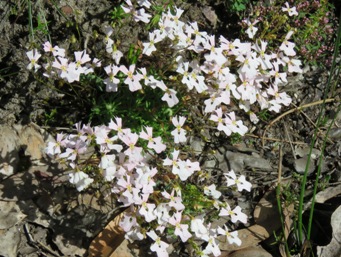Australia So Much to See
Copyright (C) 2013 AustraliaSoMuchtoSee.com. All reights reserved
Sources used for identification of wildflowers shown on these pages and regions where they occur see Credits
These pages will
feature some of the wildflowers we have photographed in Western Australia, and where possible, identified. If you
are able to help identify further flowers, or correct any I may have wrong, please contact us.
Information given for each species
will give botanical name, known common names, describe the flower, give time of year it flowered, and where it was photographed, and
the areas it occurs in. Names have been matched to Florabase which has also been used to show distribution.
To see
more Western Australian Wildflowers, see WA Now and Then Wildflower Gallery
See some of these wildflower
in larger sized photos on our Flickr pages.




Uncertain: Stylidium dielsianum, Tangle Triggerplant (identification not confirmed)
While Stylidium dielsianum is usually pink
with darker pink centre markings, this dome shaped cluster has tiny mauve lopside triggerplant flowers with small purple
spots near centre.
Spring
Yalgoo in the Mid West region, Western Australia. Stylidium dielsianum is
recorded through the south eastern Wheatbelt and Goldfields regions but has not been recorded in the Shire of Yalgoo where
the above was found
Stylidium androsaceum
Tiny white triggerplant with a serrated edge to top petals and darker coloured markings near centre with several
flowers to a stem on a low growing plant from a base foliage rosette (at right), and can have varying amounts or tinges of pink.
These tiny flowers are between one and two centimetres long. They fold shut like a book at night. Top right shows
partially folded. They have a nectary spur at the rear of the flower.
Spring
Bridgetown, South West region, Western
Australia.
Found in the Mid West, Wheatbelt, South West, Great Southern on a variety of soil types.
Uncertain: Stylidium bulbiferum Circus Triggerplant. While the plant on the right has less foliage than the one on the left,
the flowers appear the same.
Tiny pink trigger flowers with maroon markings near a lighter coloured cantre, on a low growing plant
with fine pointed leaves
Lancelin, coastal Wheatbelt, Western Australia and occurs principally in coastal areas Lancelin to Bunbury

Stylidium ciliatum, Golden Triggerplant (above)
A branching flower stem with cream coloured four petaled trigger flowers, with
yellow at the base of the petal, which on the two lower petals is in the shape of an upturned letter Y. Top
right shows a salmon pink variation. Flower buds and entire stems covered in golden coloured hairs, which continue down the
stem into the foliage rosette. Base rosette has small elongated leaves tightly packed together.
Edges of leave have cilia (hairs) and a long hair from tip of each leaf. Similar to Stylidium piliferum. Top right
shows a salmon pink variation.
October
Bridgetown, South West region, Western Australia and found through the South
West, around Perth and into the adjacent Wheatbelt
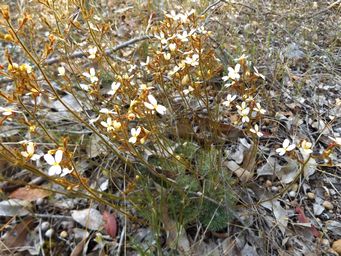
Stylidium crassifolium, Thick-leaved Triggerplant (to right and below)
Flower structure similar to Golden Triggeplant above but flowers
pale pink with darker centre marks. Leaves longer and forming a loose structured rosette
October
Bridgetown, South West region,
Western Australia and occurs around Perth, through the South West and lower Great Southern, along the south coast to Esperance
and a few incurrences in the Wheatbelt
Pollinator on Stylidium crassifolium below. Pollen can be seen sprinkled over the
insect's body.
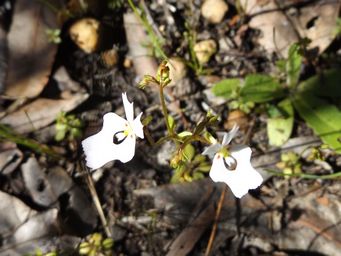
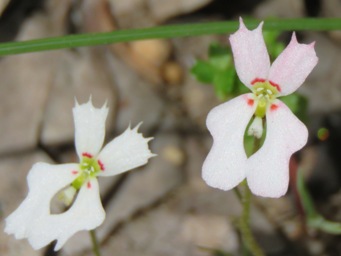

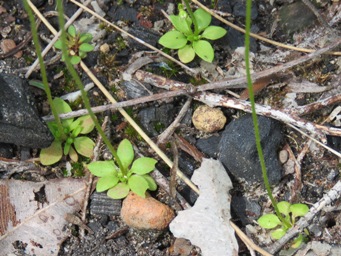





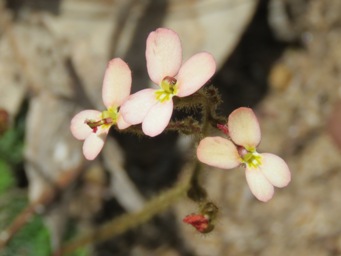

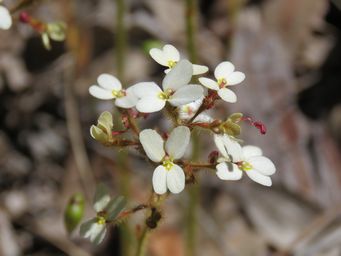

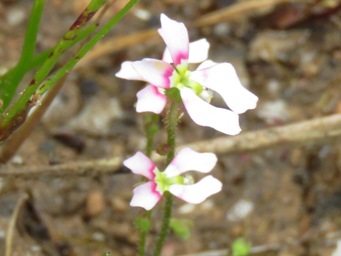
Stylidium calcaratum, Book Triggerplant
A very tiny pink and white triggerplant with a serrated edge to top petals and darker coloured
markings near centre often with the petals outside of these marks being pink, particularly the upper petals. One or several flowers
to a stem on a low growing plant from a base foliage rosette (at right). These tiny flowers are between five and ten millimetres
long. They fold shut like a book at night. They have a nectary spur at the rear of the flower.
Spring
Bridgetown,
South West region, Western Australia.
Found in the Wheatbelt and adjacent parts of the Mid West, the South West, Great Southern
and coastal Goldfields regions, favouring wet flats or near creeks and seepages.
